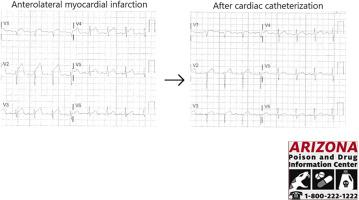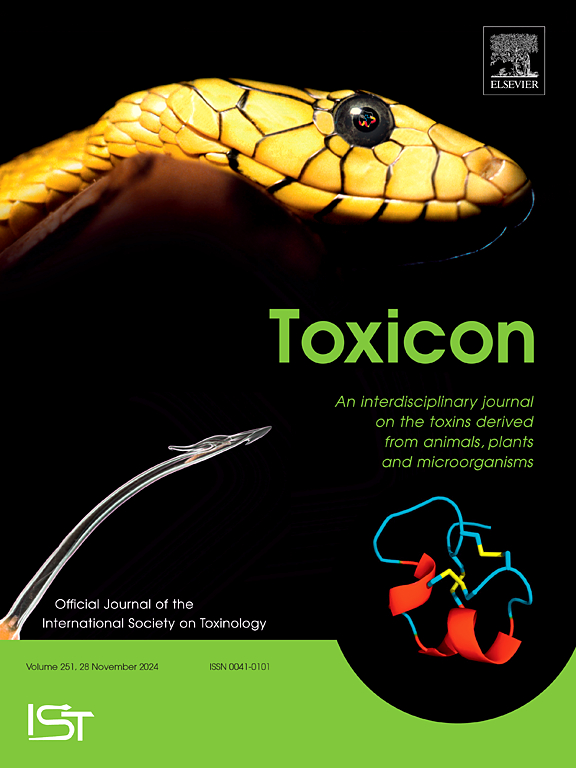Myocardial infarction during treatment of Crotalinae envenomation: A case report
IF 2.6
4区 医学
Q2 PHARMACOLOGY & PHARMACY
引用次数: 0
Abstract
While myocardial infarction is a rare, but known, potential side effect of snakebite envenomation, snake antivenom has thus far not been associated with any cardiovascular adverse events. We report the case of a 71-year-old man who developed an anterolateral MI during administration of Crotalidae immune F(ab')2 (equine) (ANAVIP), given as treatment for Crotalidae envenomation. The patient required cardiac catheterization with stenting of the left anterior descending artery and was discharged two days later on long-term clopidogrel and aspirin. Treatment of MI in the setting of envenomation should mirror typical management, with consideration of additional antivenom if the ischemia is determined to be venom-induced. Clinicians should have a high index of suspicion for patients with chest pain after snake envenomation or administration of antivenom.

治疗克罗塔林藻中毒期间的心肌梗死:病例报告
虽然心肌梗塞是蛇咬伤毒液中毒的一种罕见但已知的潜在副作用,但蛇毒抗蛇毒血清迄今尚未与任何心血管不良事件相关联。我们报告了一例 71 岁的男性病例,他在服用蛇毒血清免疫 F(ab')2 (马)(ANAVIP)治疗蛇毒中毒期间发生了前外侧心肌梗死。患者需要接受心导管检查并植入左前降支动脉支架,服用氯吡格雷和阿司匹林两天后出院。在毒液中毒的情况下治疗心肌梗死应参照典型的治疗方法,如果确定缺血是由毒液引起的,则应考虑使用额外的抗蛇毒血清。临床医生应对毒蛇咬伤或注射抗蛇毒血清后出现胸痛的患者高度怀疑。
本文章由计算机程序翻译,如有差异,请以英文原文为准。
求助全文
约1分钟内获得全文
求助全文
来源期刊

Toxicon
医学-毒理学
CiteScore
4.80
自引率
10.70%
发文量
358
审稿时长
68 days
期刊介绍:
Toxicon has an open access mirror Toxicon: X, sharing the same aims and scope, editorial team, submission system and rigorous peer review. An introductory offer Toxicon: X - full waiver of the Open Access fee.
Toxicon''s "aims and scope" are to publish:
-articles containing the results of original research on problems related to toxins derived from animals, plants and microorganisms
-papers on novel findings related to the chemical, pharmacological, toxicological, and immunological properties of natural toxins
-molecular biological studies of toxins and other genes from poisonous and venomous organisms that advance understanding of the role or function of toxins
-clinical observations on poisoning and envenoming where a new therapeutic principle has been proposed or a decidedly superior clinical result has been obtained.
-material on the use of toxins as tools in studying biological processes and material on subjects related to venom and antivenom problems.
-articles on the translational application of toxins, for example as drugs and insecticides
-epidemiological studies on envenoming or poisoning, so long as they highlight a previously unrecognised medical problem or provide insight into the prevention or medical treatment of envenoming or poisoning. Retrospective surveys of hospital records, especially those lacking species identification, will not be considered for publication. Properly designed prospective community-based surveys are strongly encouraged.
-articles describing well-known activities of venoms, such as antibacterial, anticancer, and analgesic activities of arachnid venoms, without any attempt to define the mechanism of action or purify the active component, will not be considered for publication in Toxicon.
-review articles on problems related to toxinology.
To encourage the exchange of ideas, sections of the journal may be devoted to Short Communications, Letters to the Editor and activities of the affiliated societies.
 求助内容:
求助内容: 应助结果提醒方式:
应助结果提醒方式:


